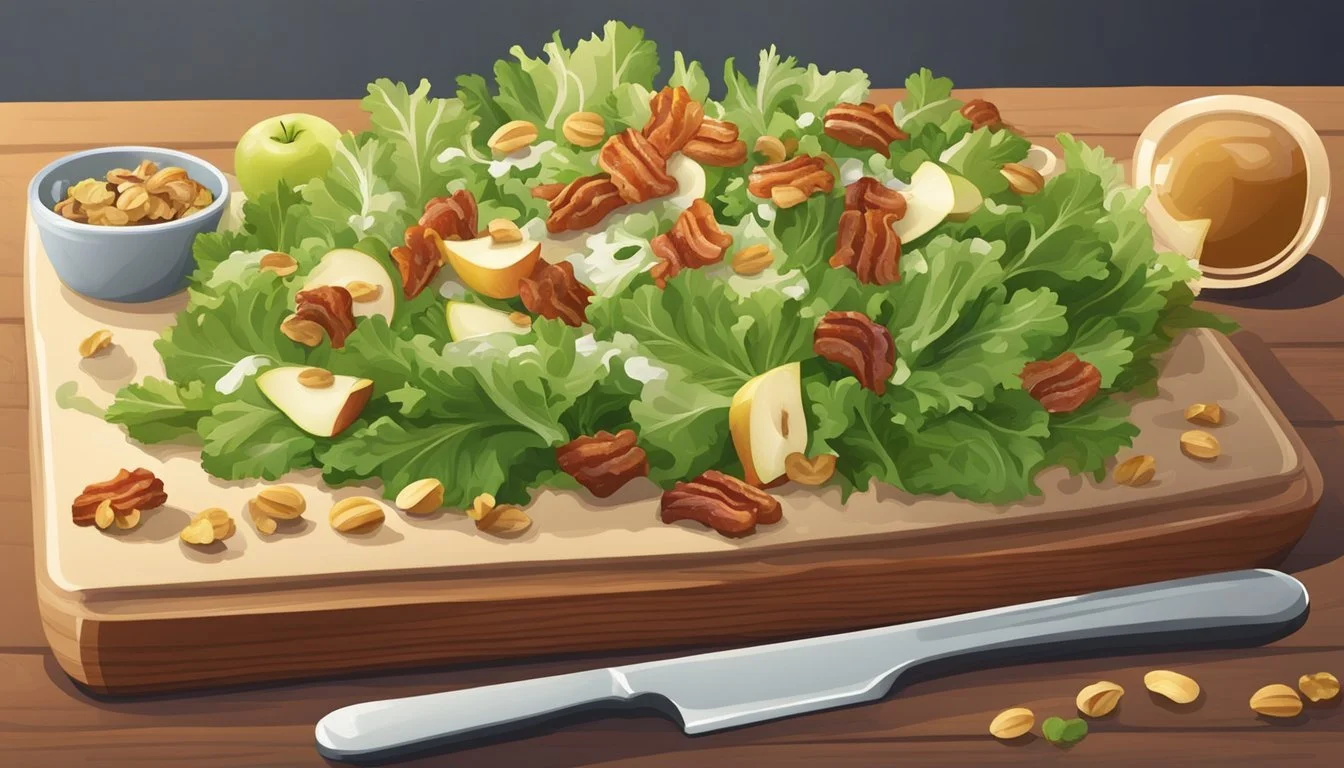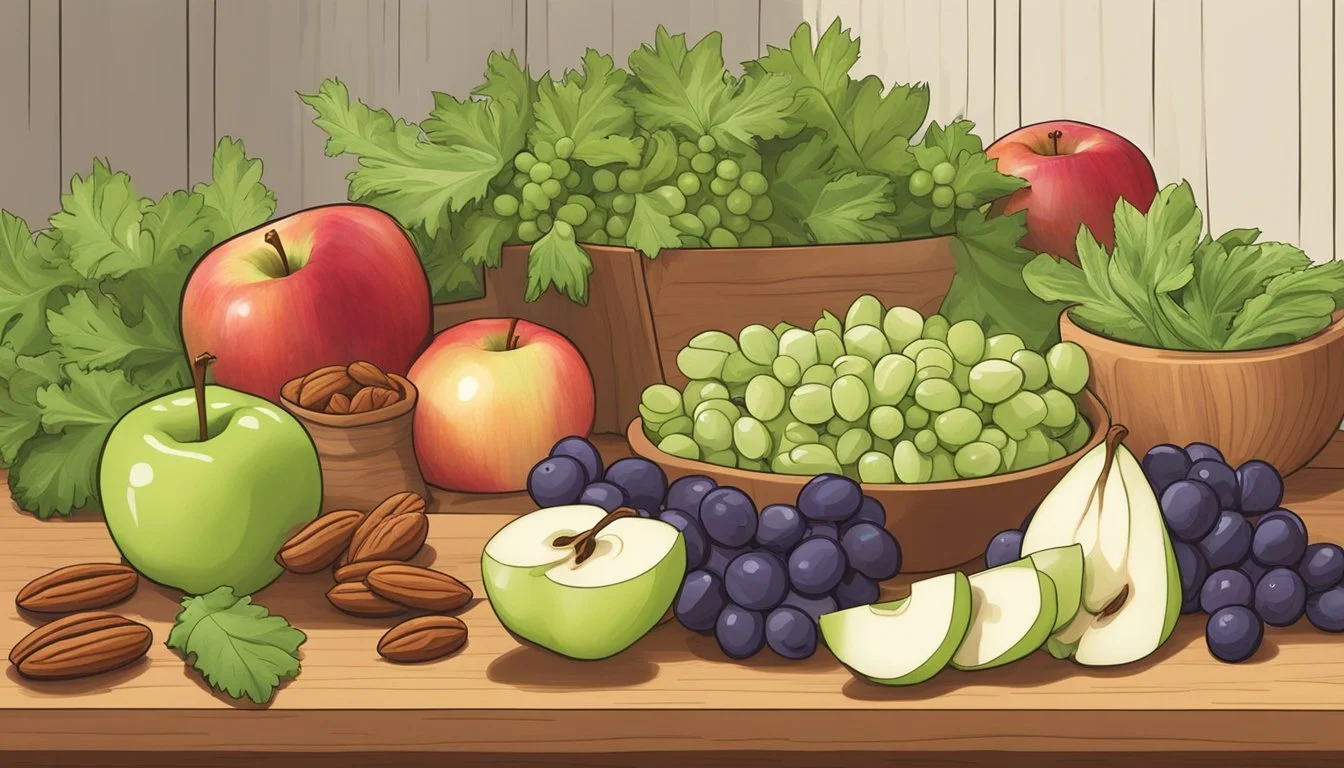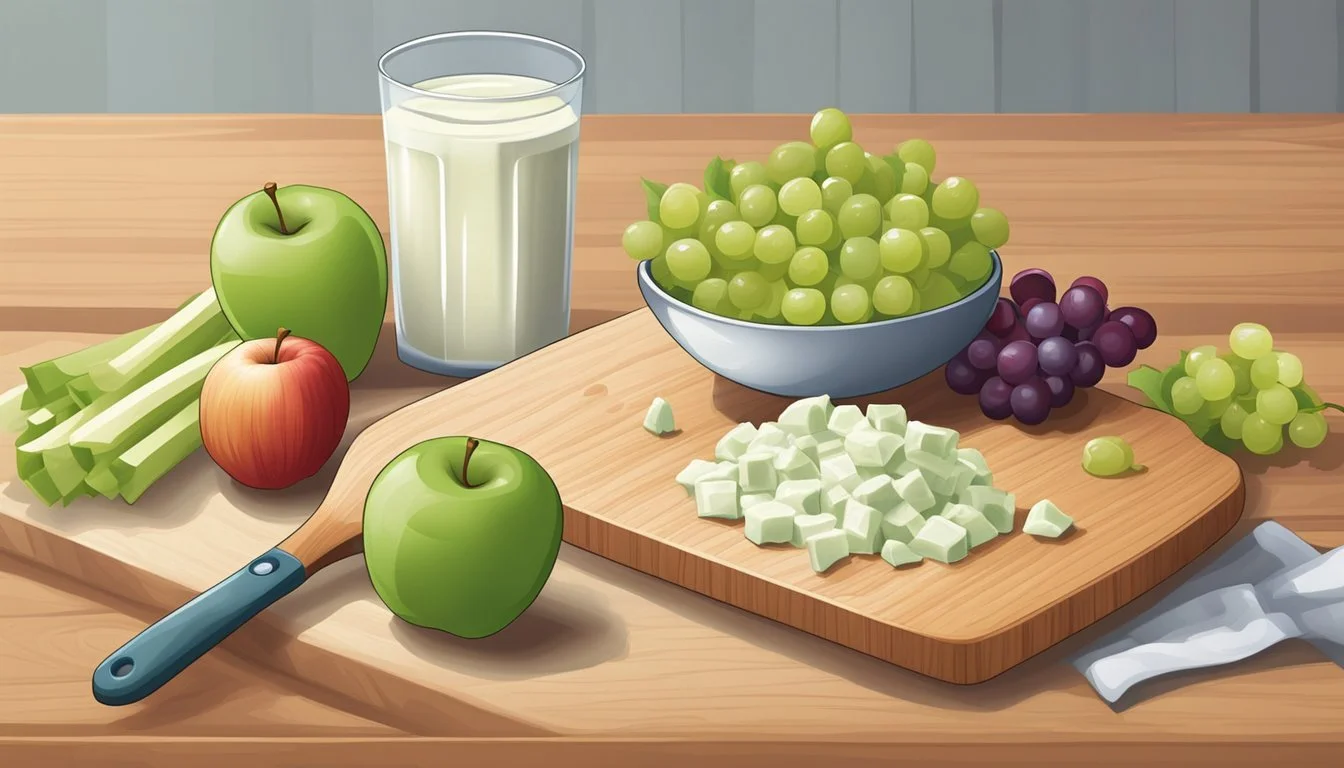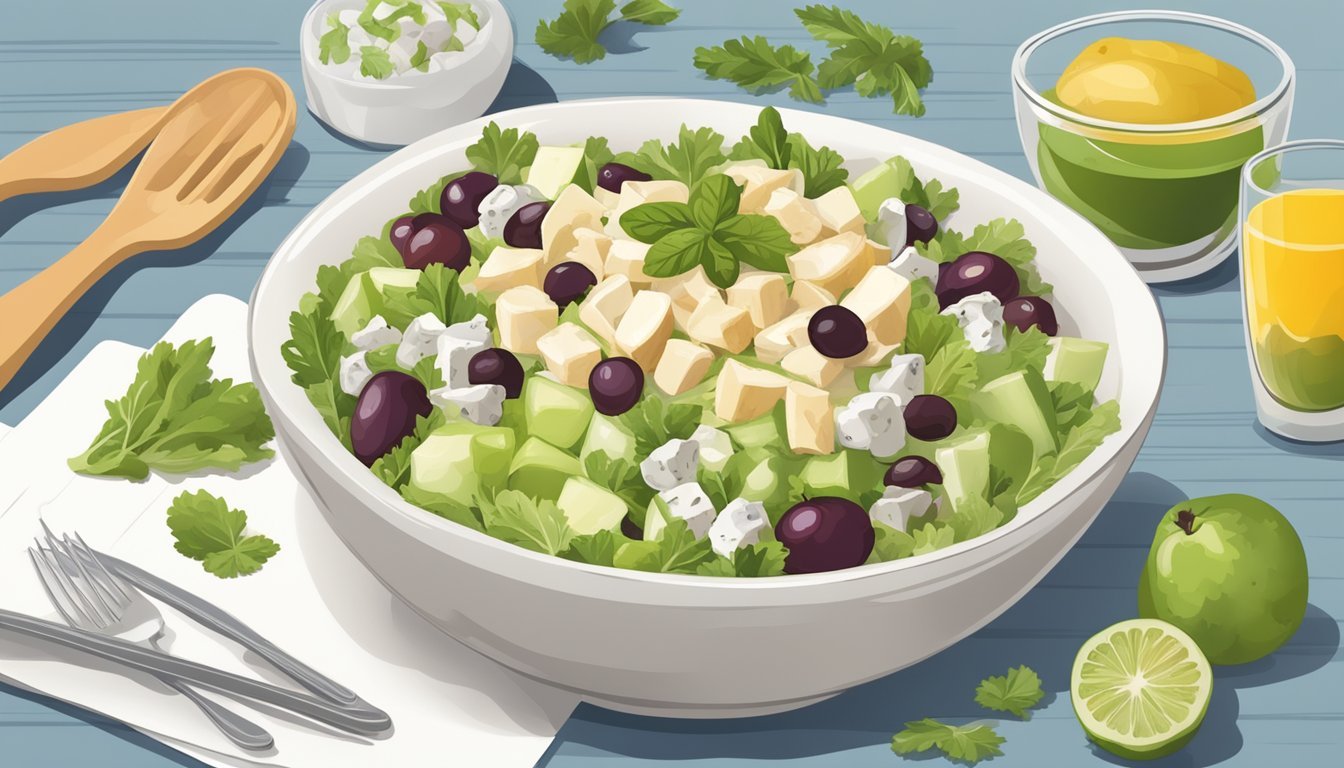How to Prepare a Texas-Style Waldorf Salad
A Guide to a Southern Twist on a Classic
A Texas-Style Waldorf Salad captures the essence of the classic dish with a few distinct touches that embrace the bold flavors associated with the Lone Star State. This refreshing salad traditionally consists of fresh apples, celery (how long does celery last?), and nuts, all tossed in a creamy dressing. The Texas twist on this popular recipe can include the addition of ingredients such as pecans—a nut native to the state—and a hint of ground white pepper for a subtle kick to complement the sweetness of the apples and raisins typically found in the salad.
The preparation of Texas-Style Waldorf Salad is straightforward and allows for flexibility, making it a versatile choice for gatherings and family meals. A mixture of crisp apples and crunchy celery provides a satisfying texture contrast, while the inclusion of pecans adds a southern flair to the dish. To ensure a balance of flavors, the salad dressing often combines mayonnaise with a touch of citrus from lemon juice, which helps to prevent the apples from browning and adds a fresh zing to the overall taste.
To serve, the salad is usually chilled, allowing the flavors to meld together and the dressing to thicken, enhancing the dish's creamy texture. The final presentation can vary, with some opting to serve the salad on a bed of lettuce or to garnish with additional apple slices or pecans for an appealing and inviting presentation. Whether as a side dish or a light meal, the Texas-Style Waldorf Salad is a delightful blend of texture, taste, and tradition with a regional twist.
Salad Fundamentals
Crafting a Texas-Style Waldorf Salad merges traditional Waldorf elements with a Southern twist. This section will guide readers through the unique characteristics of this dish and the essential components required for preparation.
Understanding Texas-Style Waldorf Salad
The Texas-Style Waldorf Salad stands out with its bold and hearty flavors, offering a twist on the classic by incorporating ingredients inspired by the Southern palate. This variation maintains the core concept of the original Waldorf Salad, which traditionally includes apples, celery, and mayonnaise, but it often embraces additional ingredients like Texas pecans or a hint of spice to provide warmth and depth. When preparing a Texas-Style Waldorf Salad, one aims to achieve a balance of textures and flavors that are satisfying and true to the roots of both Texas cuisine and the Waldorf legacy.
Ingredients Overview
When assembling a Texas-Style Waldorf Salad, each ingredient is selected to complement the overall dish, offering a fusion of crunch, creaminess, and a hint of sweetness. Below is an overview of the usual components, which can be adjusted to taste or for preferred serving size:
Apples: A crisp, sweet variety is typically chosen; they are diced to form the base of the salad.
Celery: Adds a refreshing crunch to the texture profile.
Grapes: Can be halved or left whole for bursts of sweetness.
Nuts: Pecans are preferred to align with Texas tradition, toasted for enhanced flavor.
Dressing: A combination of mayonnaise and a hint of lemon for a creamy yet tangy dressing, sometimes with a dollop of yogurt for extra body.
Spices: Salt and pepper, with optional additions like paprika or a pinch of cayenne to bring warmth.
Greens: Romaine or iceberg lettuce provides a fresh bed for the salad ingredients.
Prep Time Cook Time Total Time 20 min 0 min 20 min
Servings: This recipe typically yields enough for 4 servings, making it ideal for family meals or small gatherings.
The recipe is designed for busy individuals, as there is no cook time involved, only preparation. This allows them to deliver a wholesome and flavorful dish without spending hours in the kitchen.
Preparing the Base
The base of a Texas-Style Waldorf Salad sets the foundation for the dish, where the right potatoes and their preparation are crucial for the perfect texture and taste.
Potato Selection and Cooking
For a Texas-Style Waldorf Salad, chefs often prefer using Yukon Gold potatoes or Russet potatoes. The Yukon Golds provide a buttery taste and a creamy texture, while Russets are starchy, lending to a fluffier consistency. One should select medium-sized potatoes without any green spots or sprouts.
Potato Type Texture Taste Yukon Gold Creamy Buttery Russet Fluffy Mild, starchy
When cooking the potatoes, one must wash them thoroughly and place them in a pot of salted boiling water. They are cooked until they are fork tender, which typically takes about 15-20 minutes, depending on their size.
Cooling and Cutting Techniques
After cooking, the potatoes must be cooled quickly to stop the cooking process and maintain their texture. It is best to drain them and let them cool on a baking sheet. Once cooled, they should be cut into bite-sized pieces, which allows for a consistent look and ensures they absorb the dressing evenly.
Hard-boiled eggs are another integral part of the base. They should be boiled just enough so that the yolk is fully set but not overcooked, resulting in a crumbly texture that contrasts well with the softer potatoes. Once cooled, they are peeled and chopped into small dices before being added to the salad.
Dressing the Salad
The key to a Texas-Style Waldorf Salad lies in its dressing, which sets the stage for a hearty and flavorful experience. The dressing combines creamy textures with a balance of tangy and spicy flavors that cater to the bold tastes associated with Texas cuisine.
Creating a Creamy Texas Dressing
A foundational component of the dressing is a combination of mayonnaise and cream. Here is a simple guideline to create the base:
Start with 1/2 cup of full-fat mayonnaise for its richness.
Add 1/4 cup of heavy cream to introduce a smooth and luxurious texture.
Whisk the mayonnaise and cream together until fully combined and set aside.
For a twist on traditional Waldorf dressings, a Texan version might include a splash of olive oil to enhance the mouthfeel and provide a subtle, fruity background note. Incorporate 2 tablespoons of extra-virgin olive oil into the mix for this purpose.
Seasonings and Flavor Balancing
The seasoning for this Texas-style dressing requires precision to achieve a balance between tanginess, sweetness, and a hint of heat. Below is a breakdown of seasonings to be added:
Salt: A pinch to taste (approximately 1/4 teaspoon).
Black pepper: Freshly ground for a piquant touch (about 1/8 teaspoon).
Sugar: 1 teaspoon to offset the acidity and add mild sweetness.
Dijon mustard or yellow mustard: 1 tablespoon for a tangy kick and to help emulsify the dressing.
Vinegar: 2 tablespoons of a robust vinegar, like apple cider or red wine vinegar, provide the necessary acidity.
After adding the seasonings, it's important to vigorously whisk everything together to ensure a homogenous and emulsified dressing. Taste and adjust the levels of salt, sugar, and vinegar as needed to create a harmonious flavor profile. For those who appreciate a spicier note, a dash of cayenne pepper or finely diced jalapeños can be added to align with the Texas theme.
Adding Crunch and Texture
To achieve the hallmark texture of a Texas-Style Waldorf Salad, one must judiciously select ingredients that contribute both crunch and a complementing flavor profile.
Incorporating Vegetables and Fruits
Celery is a non-negotiable component when aiming for crunch. It should be sliced in thin, bite-sized pieces to distribute its crispness throughout the salad. Apples, another quintessential ingredient, offer a sweet, firm bite and should be used generously. They are preferably diced to ensure their presence is felt in every spoonful.
Vegetables and Fruits to Incorporate:
Celery: Thinly sliced
Apples: Diced or chopped
Nuts and Extras
Walnuts and pecans are the nuts of choice, with a slight emphasis on walnuts for their rich, earthy undertones that resonate well with Texan flavors. These should be toasted to enhance their crunchiness and depth of flavor. Additionally, pickle, specifically dill pickle relish or pickled onions, can be introduced to contribute a zesty tang and subtle snap that balances out the sweetness of the fruits.
Nuts to Toast:
Walnuts
Pecans
Extras for Zest and Crunch:
Dill Pickle Relish
Pickled Onions (optional)
Each element serves the dual purpose of invigorating the salad with varied textures and a harmonic explosion of taste.
Customizing Your Salad
When preparing a Texas-Style Waldorf Salad, the flexibility of ingredients allows for a range of customizations to accommodate different dietary preferences and to introduce additional flavors and textures.
Incorporating Protein
Adding protein to a Waldorf Salad transforms it from a side dish to a hearty main course. Grilled chicken is a popular choice that complements the crunchy texture of the apples and celery. For a classic touch, one can opt for chopped hardboiled eggs or crispy bacon, enhancing the salad with a savory depth. Below is a table of recommended protein additions and their preparation styles:
Protein Addition Preparation Suggestion Grilled Chicken Season with Texan spices and grill until cooked through; dice into bite-sized pieces. Hardboiled Eggs Cook until yolks are firm; chop into small chunks or slices. Crispy Bacon Fry until crisp; crumble or chop into bite-sized pieces.
Vegetarian and Vegan Variations
For a vegetarian variation, one may opt for eggs or dairy-based proteins like cheese while avoiding meat. A vegan version, however, necessitates the exclusion of all animal products. One could use tofu or tempeh as protein substitutes, making sure they are well-seasoned and cooked to add a satisfying chew. Ensuring dressings are free from honey and mayonnaise, which often contains eggs, is crucial for vegan compliance. A simple substitution is using vegan mayonnaise and maple syrup or agave nectar instead of honey.
Vegetarian Option:
Cheese cubes or shredded cheese can be added.
For added texture and protein, consider incorporating spiced roasted chickpeas.
Vegan Option:
Marinated and grilled tofu (What wine goes well with grilled tofu?) or tempeh, prepared in small cubes for easy mixing.
Vegan mayonnaise mixed with a sweetener like agave nectar or maple syrup can replace traditional dressing ingredients.
Final Touches
After assembling the fundamental elements of the Texas-Style Waldorf Salad, focusing on the final touches can elevate this classic dish. Enhancing the flavors with a Texan twist involves mindful garnishing and precise chilling.
Garnishing with Herbs and Spices
To infuse a distinctive Texas flair, one can garnish the salad with a blend of chopped cilantro and dill for freshness, and a sprinkle of cumin for a smoky undertone. To add a gentle heat, consider adding fine slices of jalapeño or a pinch of dried chiles. Here is a suggested garnish mix:
Cilantro: ¼ cup, finely chopped
Dill: 1 tablespoon, finely chopped
Cumin: ½ teaspoon, ground
Jalapeño: 1 tablespoon, thinly sliced
Dried Chiles: A pinch, crushed (optional for extra heat)
Chilling and Serving Guidelines
To serve the salad at its best, it should be properly chilled. Refrigeration is key to crisping the ingredients and blending the flavors. Refrigerate the salad for at least one hour before serving to ensure the ingredients are well-cooled and the dressing is set. The Texas-Style Waldorf Salad is best enjoyed cold, served on a bed of fresh greens for contrast and additional texture.
Additional Tips and Tricks
To prepare an exceptional Texas-Style Waldorf Salad, one needs to focus on not just the combination of flavors, but also the texture and longevity of the dish. Here are some specific suggestions to elevate your salad.
Achieving the Perfect Texture
The key to the perfect texture lies in the balance of crunchy and creamy elements. The classic Waldorf Salad relies on crisp apples and celery to provide a satisfying crunch. For a Texas twist, include bold pecans or candied walnuts, which should be lightly toasted—this not only adds a smoky nuance but also maintains their firmness. Avoid overcoating the salad with the dressing; aim for a light tangy coating that delivers flavor without causing sogginess.
Storage and Leftovers
Proper storage is crucial to keep the salad fresh. If expecting leftovers, one should store the components of the salad separately. Keep the dressed fruits and vegetables in an airtight container in the fridge, and the nuts in another container at room temperature to preserve their texture. Additionally, the introduction of olives should be done just before serving to prevent them from overpowering the dish with their briny flavor. Leftovers should be consumed within 24 hours to ensure the taste and texture remain optimal.
Serving and Pairing
A Texas-Style Waldorf Salad shines when served with appropriate side dishes and within a themed environment. The right pairings not only complement the flavors but also amplify the dining experience, especially during outdoor gatherings such as barbecues and picnics.
Complementing Dishes
For a Texas twist, incorporating elements of barbecue (BBQ) elevates the Waldorf Salad from a simple side to part of a cohesive meal. Complementing dishes include:
Grilled Meats: Barbecued brisket or pulled pork can balance the salad’s light crispness with their smokiness and rich flavors.
High Heat Vegetables: Grilled corn on the cob or roasted sweet potatoes provide a smoky sweetness that contrasts pleasantly with the fresh crunch of the salad.
Side Dish Options:
Grilled Zucchini (What wine goes well with grilled zucchini?): Mild and slightly sweet, it pairs well with the salad's creamy dressing.
Roasted Brussels Sprout with Bacon: The savory taste complements the sweetness in the salad.
Event-Themed Serving Ideas
At a cookout or picnic, presentation and theme play key roles:
Barbecue Events: Serve the salad in large, clear bowls to showcase its colors at a communal BBQ table, pairing with classic Texas BBQ staples.
Picnics: In individual jars for a personal touch, it's a refreshing choice alongside picnic favorites like sandwiches and lemonade.
Cookouts: As a side at cookouts, it adds a gourmet touch to the outdoor high-heat grilling fare, and can be neatly presented in disposable eco-friendly containers for ease and style.
Nutritional Information
When preparing a Texas-Style Waldorf Salad, one should consider the nutritional aspects carefully, especially the calorie content and how it fits into various diets.
Calorie Count and Diet Compatibility
A Texas-Style Waldorf Salad typically consists of apples, grapes, celery, and walnuts, which provide a mix of carbohydrates, fiber, healthy fats, and protein. Calories can vary depending on the choice of dressing and portion size. For instance, using a mayonnaise-based dressing will yield a higher calorie count, while opting for a Greek yogurt or a low-calorie mayonnaise substitute can reduce the total calories significantly.
The diet compatibility of the texas-style Waldorf Salad can be broad. It can fit within gluten-free diets, as the ingredients are inherently free of gluten. For a low-calorie diet, reducing the amount of nuts and dressing will make the salad more suitable. The salad could also adapt to a keto diet by omitting fruits high in sugar and focusing on the high-fat components, like walnuts and a full-fat dressing.
This salad, therefore, offers flexibility to accommodate various dietary needs, while providing valuable nutrients.
Closing Thoughts
A Texas-style Waldorf Salad offers a delightful twist to the classic recipe, incorporating elements that provide a nod to Southern cuisine. The key to mastering this dish lies in the freshness of its ingredients and the careful balance of flavors and textures.
Ingredients to Emphasize:
Apples and Celery: The crispness of these ingredients is non-negotiable for an authentic bite.
Pecans: They bring a distinctly Texan touch, replacing the traditional walnuts.
Dressing: Whipping cream with a hint of pepper adds a rich and creamy texture, diverging from the usual mayonnaise base.
The dish is best served chilled; allowing the flavors to meld together enhances the overall taste experience. Presentation-wise, serving against a backdrop of salad greens elevates the visual appeal, making it as attractive to the eye as it is to the palate.
When preparing the salad, one must be mindful to toast the pecans just until they're aromatic—this unlocks their earthy essence without risking a bitter aftertaste. A light coat of lemon juice on the apples is another critical step; it prevents browning and adds a subtle zing to the salad.
The Texas-style Waldorf Salad remains a versatile side dish, harmonizing well with an array of main courses. Its ability to adapt while maintaining its core elegance is a testament to the timelessness of the original Waldorf Salad. For anyone seeking to impress at a gathering, this salad's blend of tradition and regional flair does just that, solidifying its place on dinner tables with confidence and flair.










